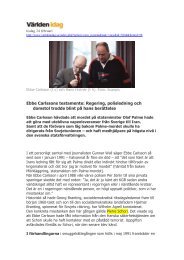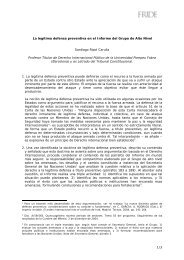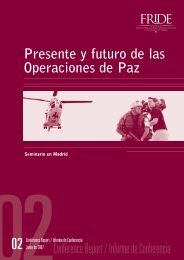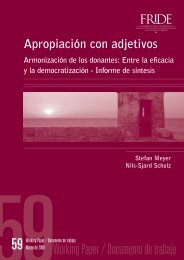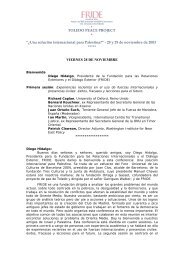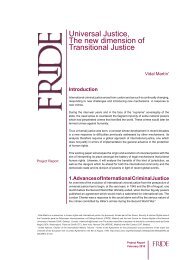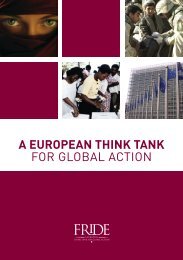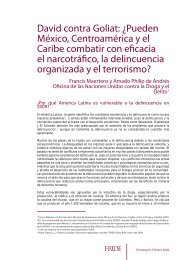Sierra Leone: Reconstructing a Patrimonial State - Fride
Sierra Leone: Reconstructing a Patrimonial State - Fride
Sierra Leone: Reconstructing a Patrimonial State - Fride
You also want an ePaper? Increase the reach of your titles
YUMPU automatically turns print PDFs into web optimized ePapers that Google loves.
11<br />
going beyond the specific court case. Today, the<br />
Criminal Court on <strong>Sierra</strong> <strong>Leone</strong> has been perceived<br />
as a large disappointment, given that the four main<br />
representatives of the three warring parties – Foday<br />
Sankoh and Sam Bockarie, RUF, Johnny Paul<br />
Koroma, AFRC and Hinga Norman CDF - died<br />
before the verdict could be issued. 27 Today, the only<br />
indicted of international relevance and interest is<br />
Charles Taylor. The arrest of Charles Taylor was<br />
widely applauded in <strong>Sierra</strong> <strong>Leone</strong> and all over Africa,<br />
thus making a case for African dictators that<br />
atrocities will not go with impunity. For security<br />
reasons his case has been referred to the<br />
International Criminal Court in The Hague. 28<br />
Aid Programming<br />
<strong>Sierra</strong> <strong>Leone</strong>, particularly after 1999, has been<br />
swamped by agencies and project approaches. Some<br />
of them were implemented by humanitarian actors,<br />
others tried to link relief with community-based<br />
development, and others started to work with the<br />
recovering governmental bodies. Out of these, three<br />
similar but distinctive approaches are being<br />
presented, considering the programming options for<br />
donor aid allocation. 29 The selection of these cases is<br />
done arbitrarily to illustrate some programming<br />
options, other programmes might have been chosen as<br />
well.<br />
From the outset it was evident that the International<br />
community was more willing to finance the Special<br />
Court than the Commission. Whereas the Special<br />
Court, conceived half a year later than the TRC, was<br />
an attempt of the international community to set<br />
standards to avoid impunity for war crimes and<br />
crimes against humanity internationally, the<br />
Commission sold itself as a more culturally rooted<br />
and closer to the people. There are serious doubts<br />
about this claim and this is being underlined by<br />
impact it has been generating. As a tool for<br />
empowering <strong>Sierra</strong> <strong>Leone</strong> citizens neither the TRC<br />
nor the Special Court have a good record so far.<br />
Prosecuting Charles Taylor, however, might set<br />
standards that make their ways in African capitals.<br />
27 Foday Sankoh died on 29 July 2003 in prison awaiting the<br />
process. The former battleground commander and link to Liberian<br />
president Taylor, Sam ‘Masquita’ Bockarie, has supposedly been killed.<br />
Johnny Paul Koroma is claimed to be found murdered while trying to<br />
pass the <strong>Sierra</strong> <strong>Leone</strong> Liberian boarder in June 2003. Hinga Norman<br />
died on 22 Feb 2007 by post-operative complications; see the notice<br />
in IRINnet from the 22.feb.2007 and the Special Report by the<br />
Berkeley War Crimes Studies Center from 22 Feb. 2007.<br />
28 International Crisis Group (2003), The Special Court for<br />
<strong>Sierra</strong> <strong>Leone</strong>: Promises and Pitfalls of a ‘New Model’, Brussels,<br />
London, Freetown http://www.crisisgroup.org/home/index.cfm?<br />
id=1803&CFID=14287120&CFTOKEN=39248079<br />
• The DFID funded Community Reintegration<br />
Project CRP. An annual volume of 3.3m EUR in<br />
2003. It was particularly focused on integrating excombatants,<br />
but unlike other programmes that<br />
targeted this group exclusively, it intended to<br />
achieve a blend of community youths and former<br />
fighters on a one-to-one basis and focussed on the<br />
rehabilitation of public infrastructure thereby<br />
symbolising reconciliation. It aimed to avoid both<br />
labelling and favouring former perpetrators. The<br />
programme management approach was to work<br />
together with locally based NGOs that would<br />
provide the services.<br />
• The Rehabilitation, Reconciliation and<br />
Reintegration Programme (ReAct) implemented<br />
by GTZ.<br />
A mixed funding by the German<br />
Government, UNHCR and DFID had a combined<br />
29 The following information relies mainly on the authors<br />
experience and on Simon Arthy (2003), Ex-Combatant Reintegration<br />
– Vol 1&2; DFID funded Reintegration Activities in <strong>Sierra</strong> <strong>Leone</strong>,<br />
Reintegration Lesson Learning and Impact Evaluation; and, Vol 3.,<br />
Key Issues for Policy Makers and Practitioners, Based on Lessons in<br />
<strong>Sierra</strong> <strong>Leone</strong>, Freetown/London (Study commissioned by DFID).<br />
<strong>Sierra</strong> <strong>Leone</strong>: <strong>Reconstructing</strong> a <strong>Patrimonial</strong> <strong>State</strong> May 2007



